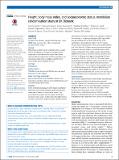| dc.contributor.author | Tyrrell, Jessica | |
| dc.contributor.author | Jones, Samuel E | |
| dc.contributor.author | Beaumont, Robin | |
| dc.contributor.author | Astley, Christina M | |
| dc.contributor.author | Lovell, Rebecca | |
| dc.contributor.author | Yaghootkar, Hanieh | |
| dc.contributor.author | Tuke, Marcus | |
| dc.contributor.author | Ruth, Katherine S | |
| dc.contributor.author | Freathy, Rachel M | |
| dc.contributor.author | Wood, Andrew R | |
| dc.contributor.author | Murray, Anna | |
| dc.contributor.author | Weedon, Michael N | |
| dc.contributor.author | Frayling, Timothy M | |
| dc.contributor.author | Hirschhorn, Joel N | |
| dc.date.accessioned | 2017-05-15T14:06:12Z | |
| dc.date.available | 2017-05-15T14:06:12Z | |
| dc.date.issued | 2016-03 | |
| dc.identifier.issn | 0959-8138 | |
| dc.identifier.issn | 1468-5833 | |
| dc.identifier.uri | http://hdl.handle.net/1721.1/109077 | |
| dc.description.abstract | Abstract
Objective To determine whether height and body mass index (BMI) have a causal role in five measures of socioeconomic status.
Design Mendelian randomisation study to test for causal effects of differences in stature and BMI on five measures of socioeconomic status. Mendelian randomisation exploits the fact that genotypes are randomly assigned at conception and thus not confounded by non-genetic factors.
Setting UK Biobank.
Participants 119,669 men and women of British ancestry, aged between 37 and 73 years.
Main outcome measures Age completed full time education, degree level education, job class, annual household income, and Townsend deprivation index.
Results In the UK Biobank study, shorter stature and higher BMI were observationally associated with several measures of lower socioeconomic status. The associations between shorter stature and lower socioeconomic status tended to be stronger in men, and the associations between higher BMI and lower socioeconomic status tended to be stronger in women. For example, a 1 standard deviation (SD) higher BMI was associated with a £210 (€276; $300; 95% confidence interval £84 to £420; P=6×10⁻³) lower annual household income in men and a £1890 (£1680 to £2100; P=6×10⁻¹⁵) lower annual household income in women. Genetic analysis provided evidence that these associations were partly causal. A genetically determined 1 SD (6.3 cm) taller stature caused a 0.06 (0.02 to 0.09) year older age of completing full time education (P=0.01), a 1.12 (1.07 to 1.18) times higher odds of working in a skilled profession (P=6×10⁻⁷), and a £1130 (£680 to £1580) higher annual household income (P=4×10⁻⁸). Associations were stronger in men. A genetically determined 1 SD higher BMI (4.6 kg/m2) caused a £2940 (£1680 to £4200; P=1×10⁻⁵) lower annual household income and a 0.10 (0.04 to 0.16) SD (P=0.001) higher level of deprivation in women only.
Conclusions These data support evidence that height and BMI play an important partial role in determining several aspects of a person’s socioeconomic status, especially women’s BMI for income and deprivation and men’s height for education, income, and job class. These findings have important social and health implications, supporting evidence that overweight people, especially women, are at a disadvantage and that taller people, especially men, are at an advantage. | en_US |
| dc.language.iso | en_US | |
| dc.publisher | BMJ Publishing Group | en_US |
| dc.relation.isversionof | http://dx.doi.org/10.1136/bmj.i582 | en_US |
| dc.rights | Creative Commons Attribution-NonCommercial 3.0 Unported | en_US |
| dc.rights.uri | https://creativecommons.org/licenses/by-nc/3.0/ | en_US |
| dc.source | BMJ Publishing Group | en_US |
| dc.title | Height, body mass index, and socioeconomic status: mendelian randomisation study in UK Biobank | en_US |
| dc.type | Article | en_US |
| dc.identifier.citation | Tyrrell, Jessica; Jones, Samuel E; Beaumont, Robin; Astley, Christina M; Lovell, Rebecca; Yaghootkar, Hanieh; Tuke, Marcus et al. “Height, Body Mass Index, and Socioeconomic Status: Mendelian Randomisation Study in UK Biobank.” BMJ (March 2016): i582. © 2016 BMJ Publishing Group Ltd | en_US |
| dc.contributor.department | Broad Institute of MIT and Harvard | en_US |
| dc.contributor.mitauthor | Hirschhorn, Joel N | |
| dc.relation.journal | BMJ | en_US |
| dc.eprint.version | Final published version | en_US |
| dc.type.uri | http://purl.org/eprint/type/JournalArticle | en_US |
| eprint.status | http://purl.org/eprint/status/PeerReviewed | en_US |
| dspace.orderedauthors | Tyrrell, Jessica; Jones, Samuel E; Beaumont, Robin; Astley, Christina M; Lovell, Rebecca; Yaghootkar, Hanieh; Tuke, Marcus; Ruth, Katherine S; Freathy, Rachel M; Hirschhorn, Joel N; Wood, Andrew R; Murray, Anna; Weedon, Michael N; Frayling, Timothy M | en_US |
| dspace.embargo.terms | N | en_US |
| mit.license | PUBLISHER_CC | en_US |
